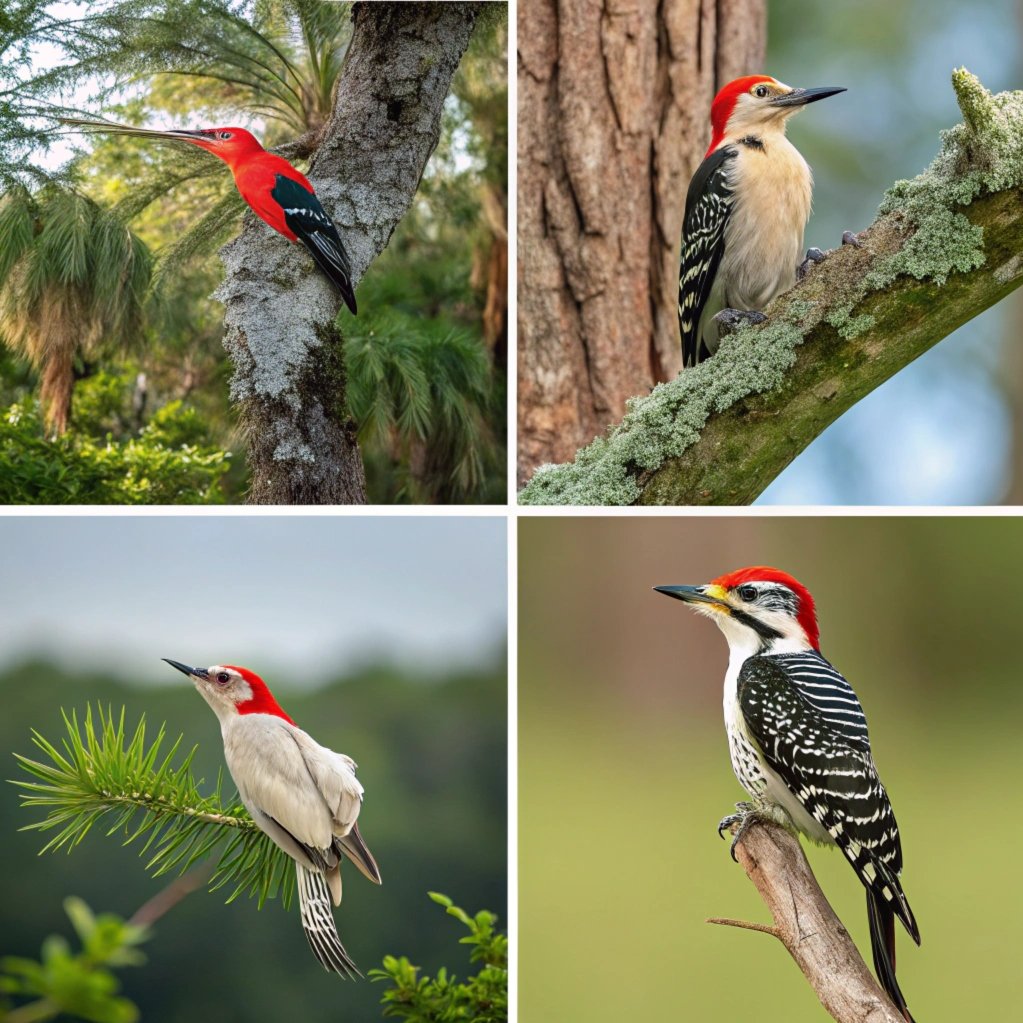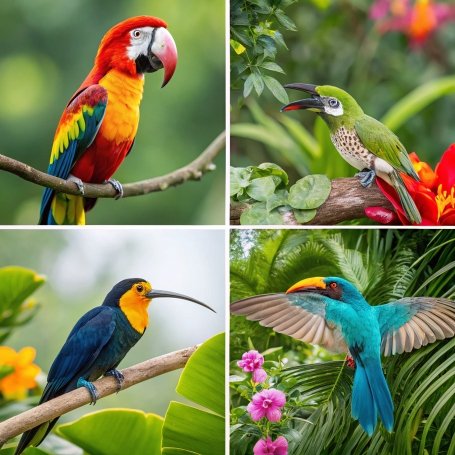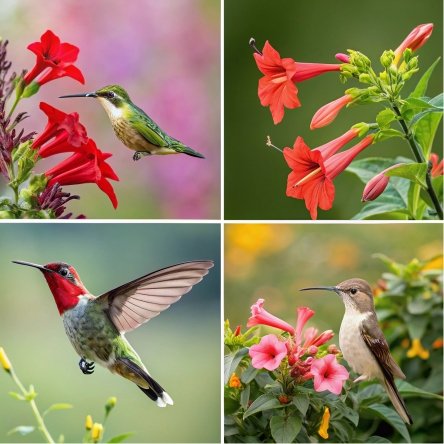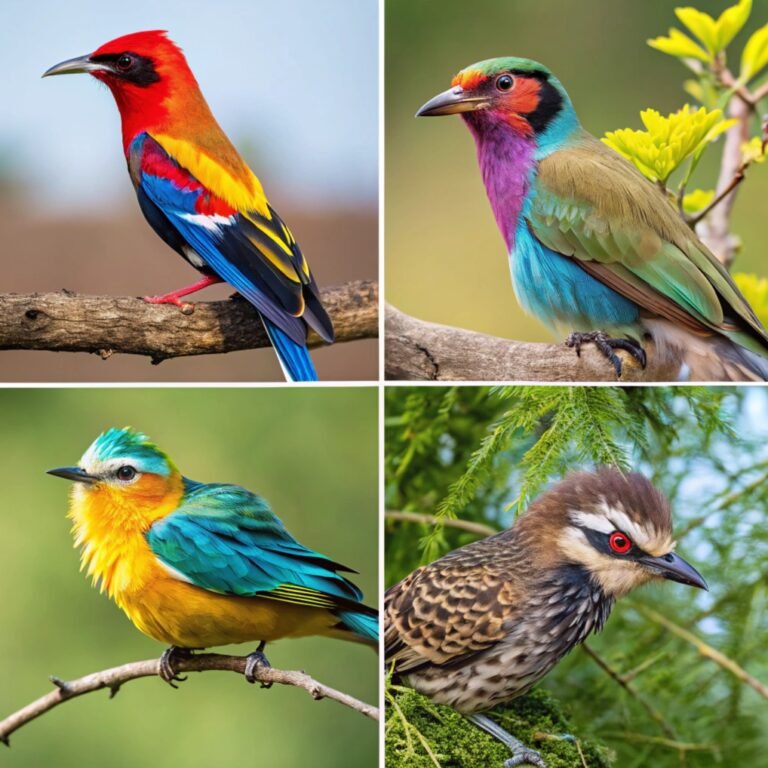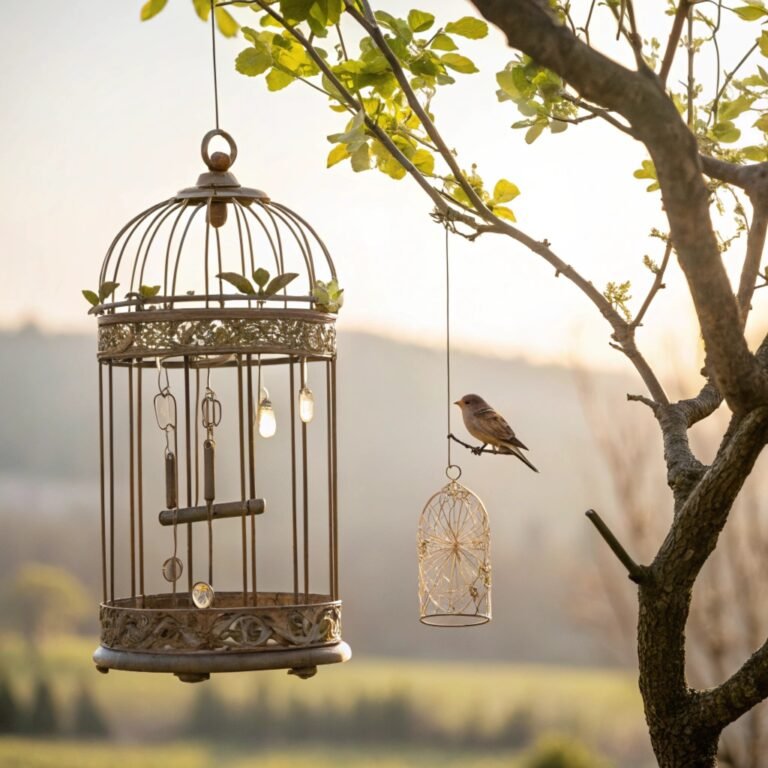The Vibrant World of 10 Florida Woodpeckers: A Comprehensive Guide to These Colorful and Fascinating Birds
Florida’s diverse ecosystems provide an ideal habitat for a variety of woodpecker species, making it a paradise for bird enthusiasts and nature lovers alike.
From the striking Pileated Woodpecker to the elusive Red-Cockaded Woodpecker, these fascinating birds play a crucial role in Florida’s ecosystem.
In this comprehensive guide, we’ll explore the unique characteristics, habitats, and behaviors of ten woodpecker species found in the Sunshine State.

Key Takeaways:
- Florida is home to at least eight common woodpecker species, with reports of up to ten species in total.
- The Red-bellied Woodpecker is the most frequently sighted woodpecker in Florida.
- Woodpeckers in Florida inhabit a variety of ecosystems, including pine forests, cypress swamps, and urban parks.
- Some species, like the Red-headed Woodpecker, have experienced population declines and are now subjects of conservation efforts.
- Florida’s woodpeckers play a vital role in controlling insect populations and creating habitats for other wildlife.
- The state’s year-round warm climate makes it an attractive destination for both resident and migratory woodpecker species.
- Artificial nest cavities and bird feeders can help support woodpecker populations in urban and suburban areas.
- Florida offers numerous birdwatching hotspots for observing woodpeckers, including national forests, state parks, and wildlife refuges.
- Woodpeckers in Florida are protected under the Migratory Bird Treaty Act.
- Understanding and appreciating these birds can contribute to their conservation and the preservation of Florida’s unique ecosystems.
The Downy Woodpecker: Florida’s Smallest Woodpecker
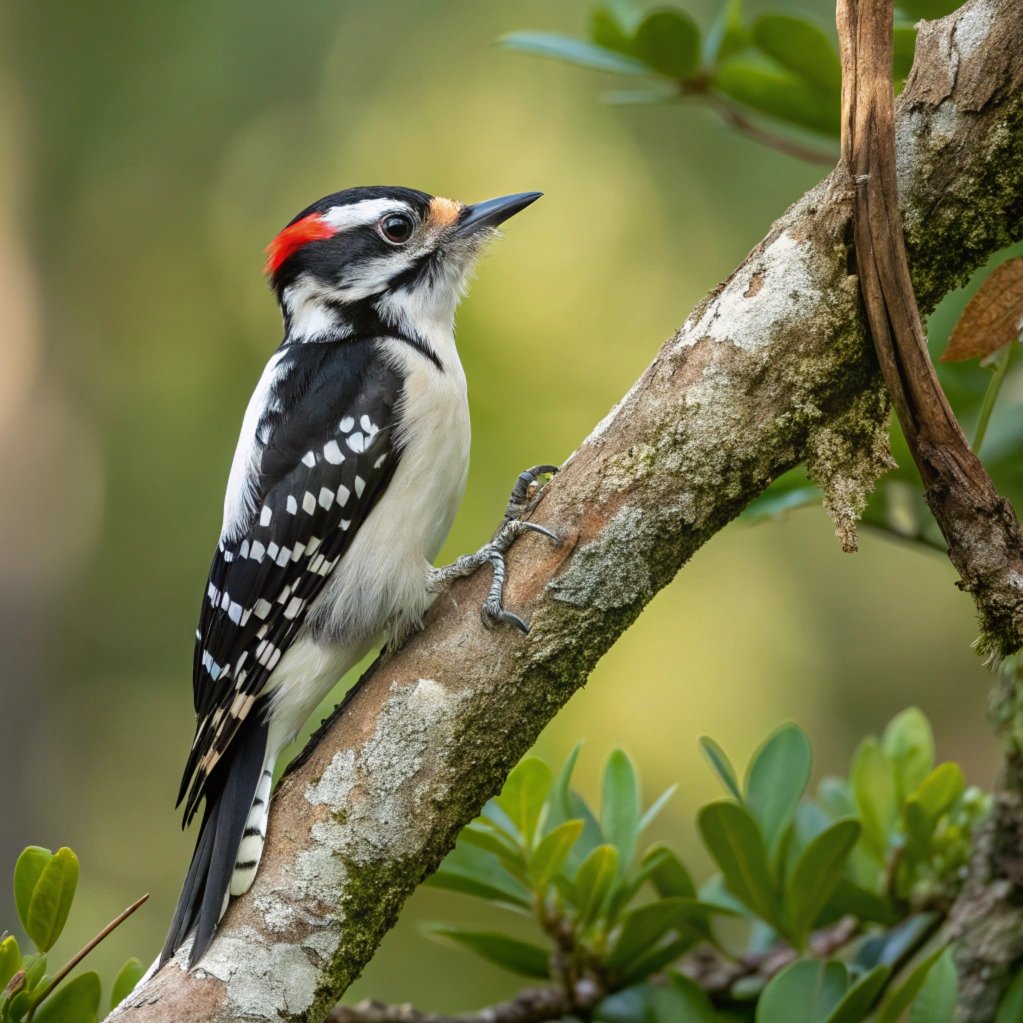
The Downy Woodpecker (Dryobates pubescens) holds the title of the smallest woodpecker species in North America and is a common sight in Florida.
This diminutive bird, measuring about two-thirds the size of its larger look-alike, the Hairy Woodpecker, is a year-round resident in the Sunshine State.
With 390,766 recorded sightings in Florida, the Downy Woodpecker is a familiar presence in both urban and rural areas. These adaptable birds can be found in a variety of habitats, including deciduous and mixed forests, parks, and even residential areas with mature trees.
The Downy Woodpecker is most active during the summer months, when its distinctive drumming and high-pitched call can be heard echoing through the trees.
Their small size allows them to forage on slender branches and twigs that larger woodpeckers cannot access, giving them a unique ecological niche in Florida’s diverse ecosystems.
The Hairy Woodpecker: A Larger Look-Alike
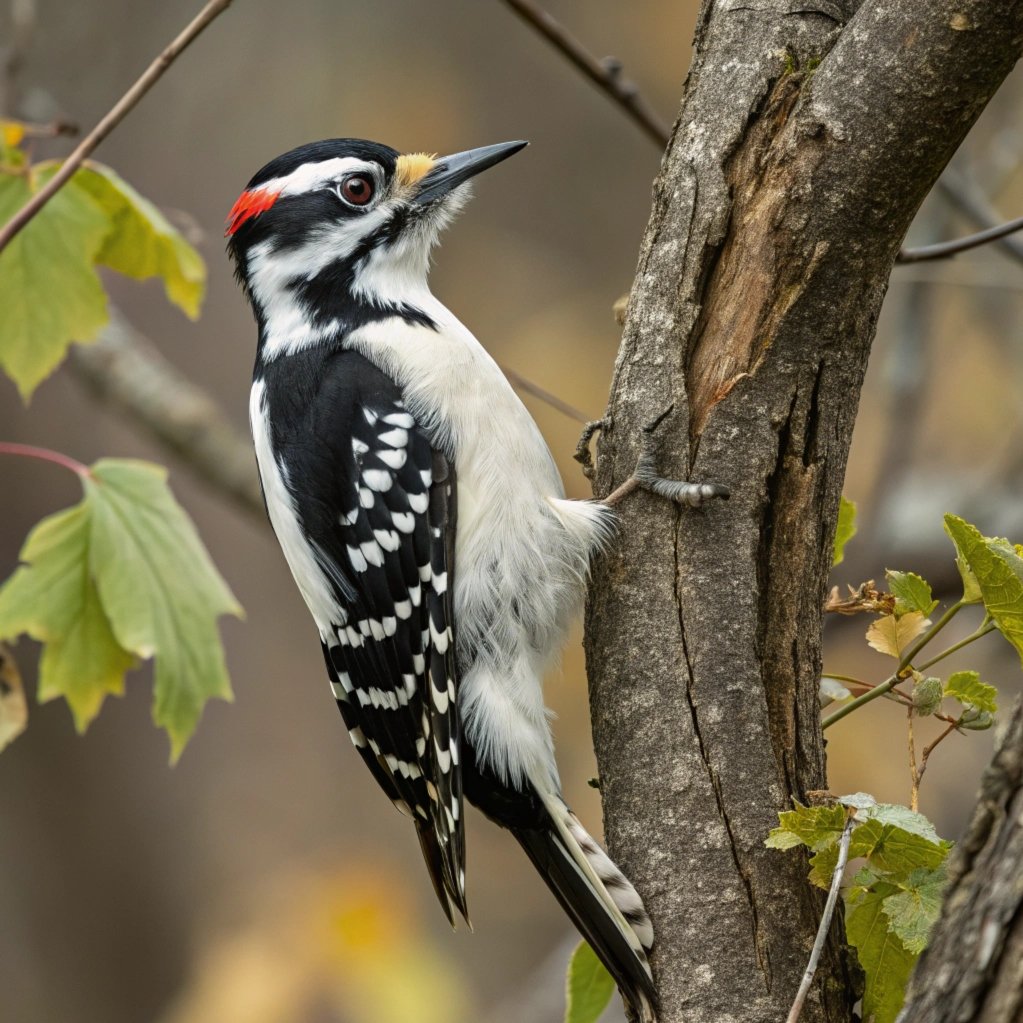
The Hairy Woodpecker (Leuconotopicus villosus) is often mistaken for its smaller cousin, the Downy Woodpecker, but a closer look reveals distinct differences. With 4,852 recorded sightings in Florida, this larger woodpecker is less common but still a year-round resident in the state.
The Hairy Woodpecker has a wider distribution range across North America, adapting to various climates from Northern Alaska to Guatemala.
In Florida, these woodpeckers can be observed foraging on tree trunks and limbs, primarily feeding on insects and larvae of wood-boring beetles. Their diet plays a crucial role in maintaining forest health by controlling pest populations that can harm trees.
The Hairy Woodpecker’s larger size and longer bill allow it to excavate deeper into tree bark, accessing food sources that smaller woodpeckers cannot reach.
This species prefers mature forests and large trees, making Florida’s diverse woodlands an ideal habitat for their foraging and nesting activities.
The Red-bellied Woodpecker: Florida’s Most Common Woodpecker

Despite its name, the Red-bellied Woodpecker (Melanerpes carolinus) is most recognizable by the bright red cap on its head rather than its subtly red-tinged belly.
This medium-sized woodpecker is the most frequently sighted woodpecker species in Florida, with numerous observations recorded throughout the state. Highly adaptable, the Red-bellied Woodpecker thrives in various habitats, including pine forests, wetlands, and urban parks.
These birds are known for their distinctive rolling call and their habit of storing food in tree crevices. The Red-bellied Woodpecker’s diet is diverse, consisting of insects, fruits, nuts, and even small vertebrates.
Their presence in Florida is beneficial as they help control insect populations and disperse seeds. During breeding season, which typically begins in May, males attract mates by drumming on resonant surfaces and calling out.
The species’ ability to adapt to human-altered landscapes has contributed to its success and widespread distribution across the state.
The Red-headed Woodpecker: A Striking but Declining Species
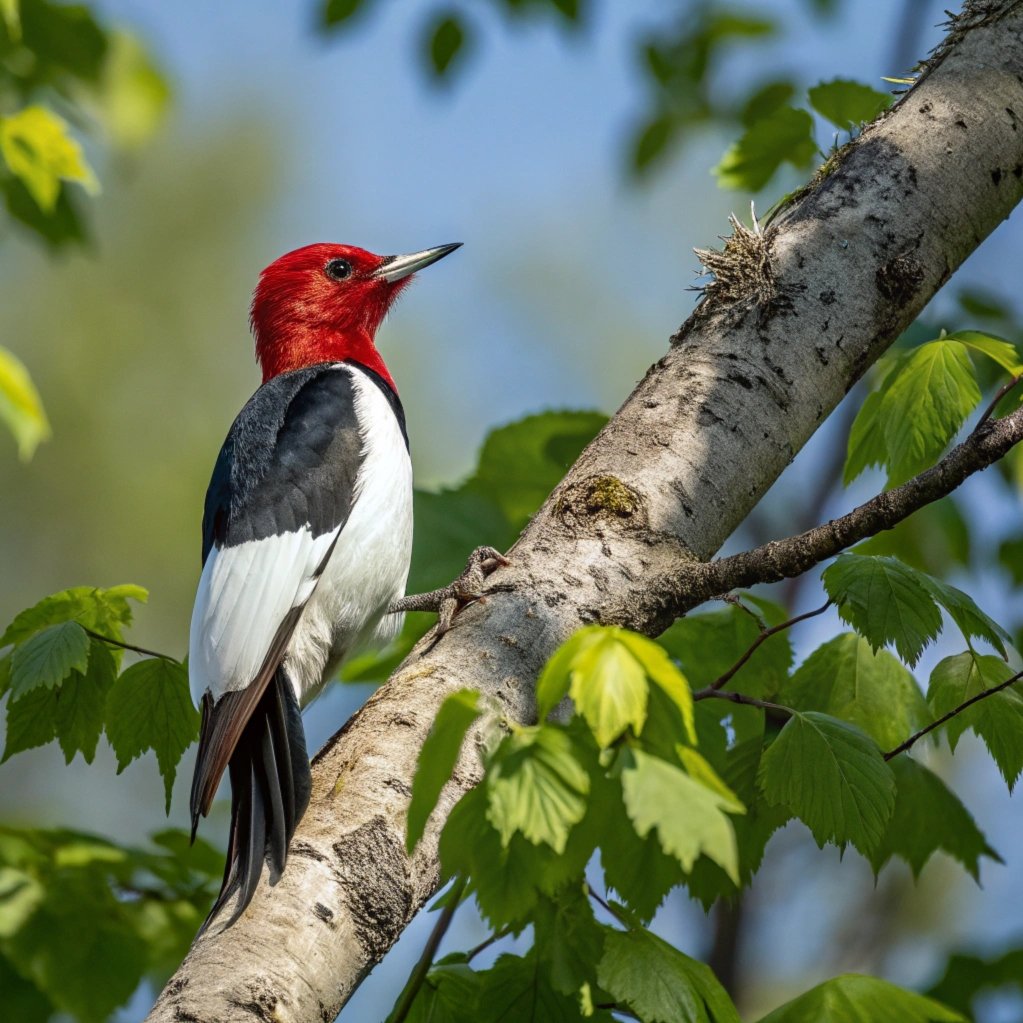
The Red-headed Woodpecker (Melanerpes erythrocephalus) is one of the most visually striking woodpecker species found in Florida, with its bold red head, black back, and white underparts.
With 41,532 recorded sightings in the state, this species can be found year-round in northern and central Florida, with increased numbers during migration periods.
Unlike most woodpeckers, the Red-headed Woodpecker is known for its unique foraging behavior, often catching insects in mid-air. This species also feeds on fruits, nuts, and seeds, making it an important contributor to seed dispersal in Florida’s ecosystems.
However, the Red-headed Woodpecker has faced significant challenges in recent decades, with a 54% population decline over the past 50 years. This decline is primarily attributed to habitat loss and a reduction in suitable food sources.
As a result, the species has been placed on the Yellow Watch List, highlighting the need for conservation efforts to protect and restore its populations in Florida and across its range.
The Pileated Woodpecker: Florida’s Largest Woodpecker
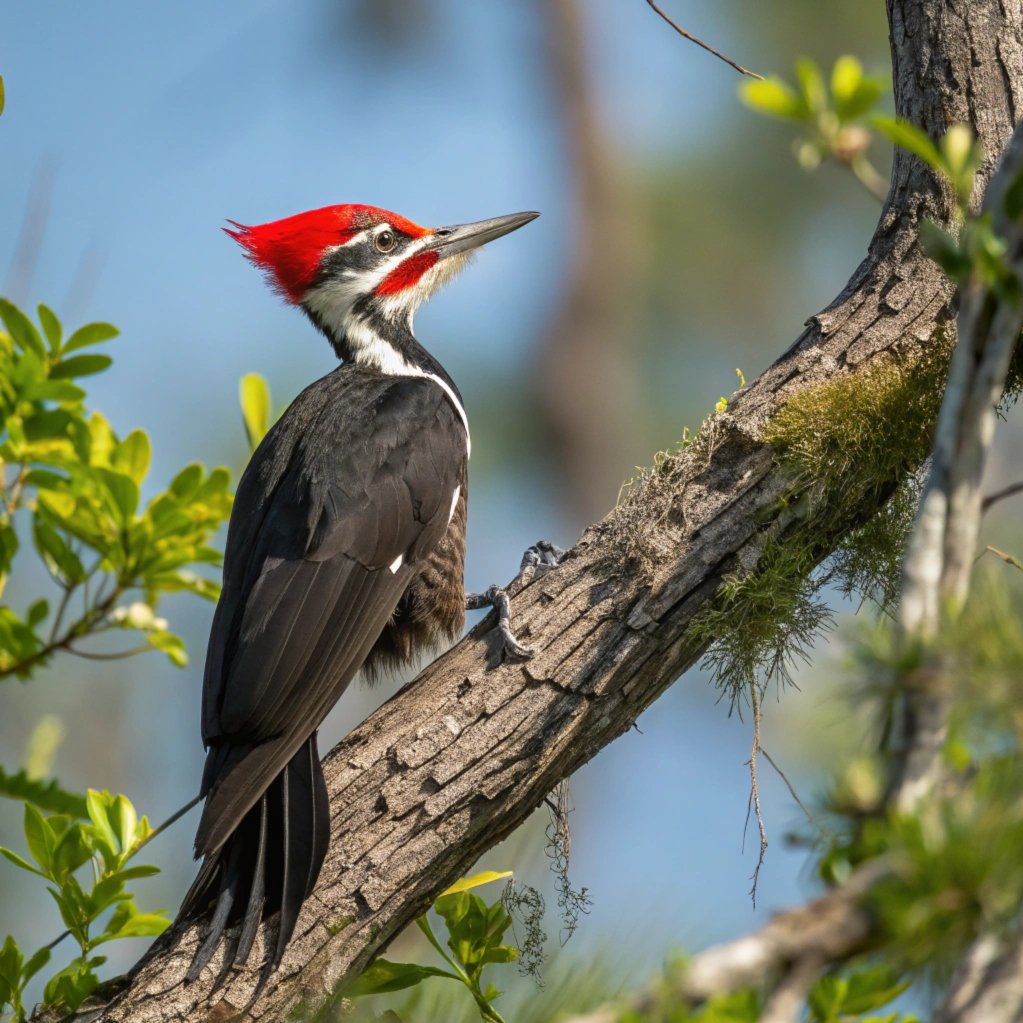
The Pileated Woodpecker (Dryocopus pileatus) is an impressive sight in Florida’s forests, standing out as the largest woodpecker species in the state.
With its distinctive red crest and striking black and white plumage, this bird is often referred to as the “Woody Woodpecker” due to its resemblance to the famous cartoon character.
Weighing in at about 10.5 ounces, the Pileated Woodpecker is a formidable presence in Florida’s woodlands. These birds prefer mature forests with large trees, where they excavate distinctive rectangular holes in search of their primary food source: carpenter ants and wood-boring beetle larvae.
The Pileated Woodpecker’s powerful bill and strong neck muscles allow it to create cavities that serve as crucial habitats for other wildlife species.
In Florida, the best places to observe these magnificent birds include the Apalachicola National Forest, Osceola National Forest, and various state parks such as Myakka River State Park and Wekiwa Springs State Park.
Their loud, resonant calls and drumming can often be heard echoing through the forest, making them an exciting species for birdwatchers to locate and observe.
The Northern Flicker: A Ground-Foraging Woodpecker
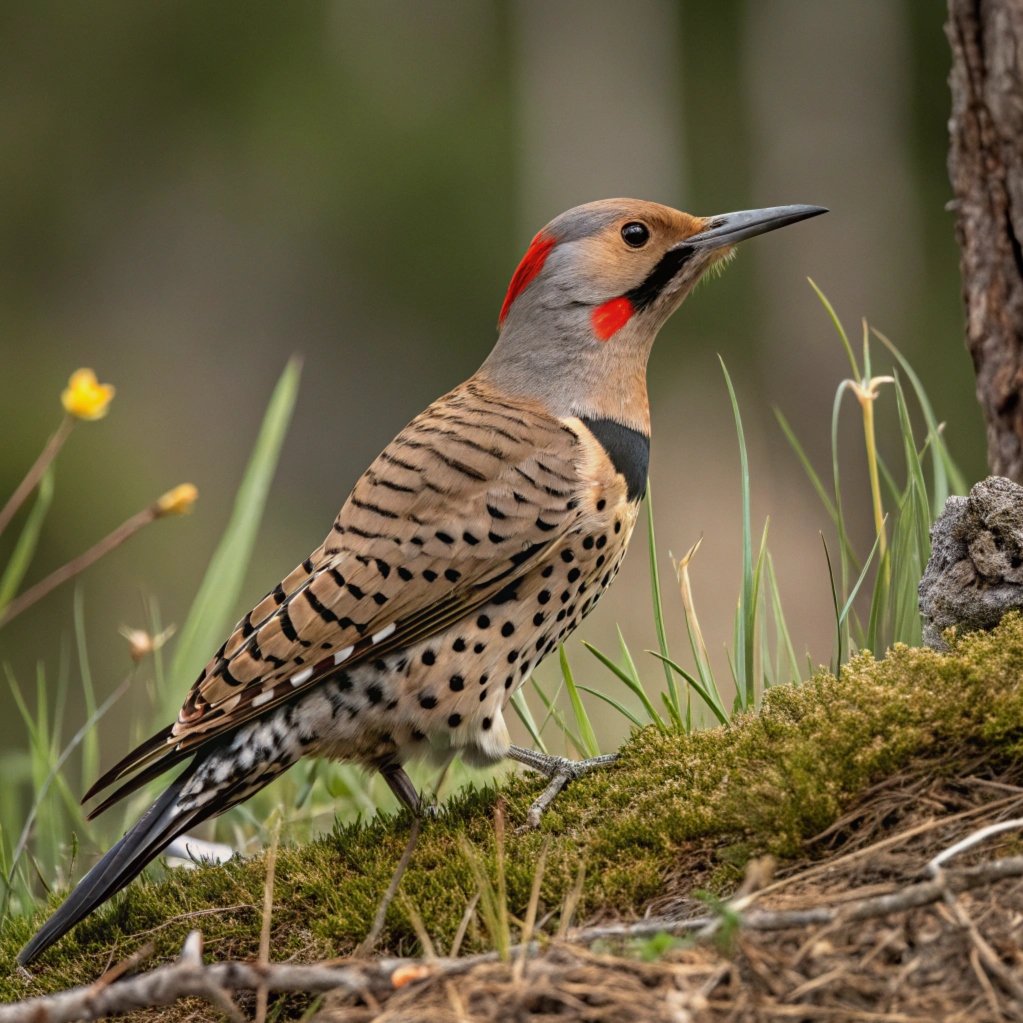
The Northern Flicker (Colaptes auratus) stands out among Florida’s woodpeckers for its unique ground-foraging behavior. This medium-sized woodpecker, weighing about 4.7 ounces, is the second-largest woodpecker species in the state after the Pileated Woodpecker.
Unlike most of its tree-clinging relatives, the Northern Flicker spends a significant amount of time on the ground, probing for ants and beetles with its slightly curved bill.
In Florida, observers can spot two distinct subspecies: the Yellow-shafted Flicker in the northern part of the state and the Red-shafted Flicker in the western panhandle.
These birds are easily recognizable by their brown plumage with black barring, a black bib, and bright yellow or red underwing feathers visible during flight.
Northern Flickers play a crucial role in Florida’s ecosystems by controlling ant populations and creating nesting cavities that benefit other bird species.
They can be found in open woodlands, forest edges, and even urban parks throughout the state, making them a common and welcome sight for Florida’s bird enthusiasts.
The Red-cockaded Woodpecker: Florida’s Endangered Forest Dweller
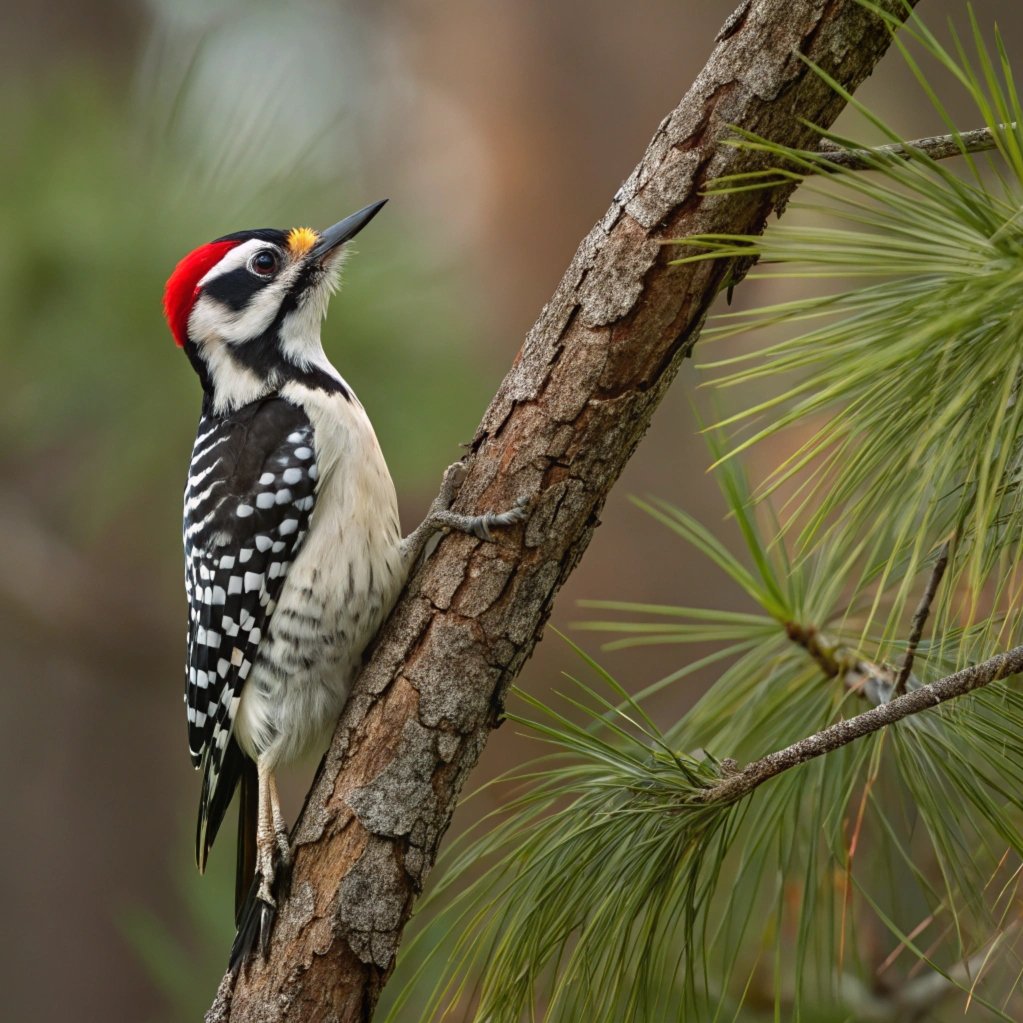
The Red-cockaded Woodpecker (Leuconotopicus borealis) is a small woodpecker species that holds a special place in Florida’s conservation efforts. Unlike other woodpeckers, this species is unique in its preference for nesting in living pine trees, particularly longleaf pines.
The Red-cockaded Woodpecker gets its name from the small red streak or “cockade” on the male’s head, which is rarely visible. These birds are considered endangered due to the loss of their specific habitat requirements.
In Florida, conservation efforts focus on preserving and managing mature pine forests to support Red-cockaded Woodpecker populations.
The species plays a crucial role in its ecosystem by creating cavities that are used by many other wildlife species. Birdwatchers interested in spotting this elusive woodpecker should visit managed pine forests in areas such as the Apalachicola National Forest or the Ocala National Forest.
The Red-cockaded Woodpecker’s conservation story highlights the importance of preserving Florida’s diverse habitats and the intricate relationships between species and their environments.
The Yellow-bellied Sapsucker: A Winter Visitor to Florida
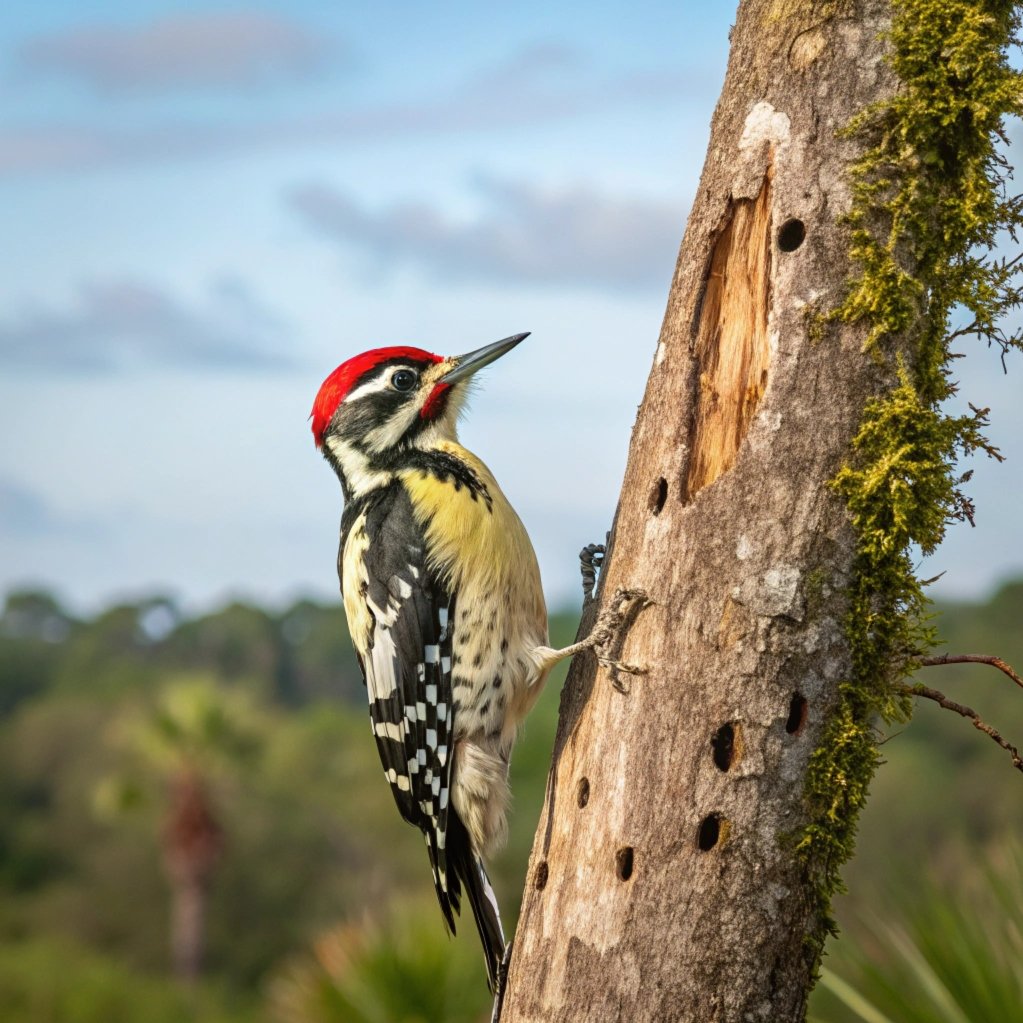
The Yellow-bellied Sapsucker (Sphyrapicus varius) is a unique woodpecker species that visits Florida during the winter months. Unlike other woodpeckers that primarily feed on insects, sapsuckers, as their name suggests, drill small holes in trees to feed on sap and the insects attracted to it.
These birds are smaller than most Florida woodpeckers and are recognizable by their black and white plumage with a red forehead and, in males, a red throat.
The Yellow-bellied Sapsucker’s feeding habits create distinctive patterns of small holes on tree trunks, which can be observed long after the bird has moved on.
While in Florida, these woodpeckers can be found in various wooded habitats, including deciduous and mixed forests, as well as in parks and suburban areas with mature trees.
Their presence in Florida during the winter months adds to the state’s avian diversity and provides birdwatchers with an opportunity to observe a species with unique feeding behaviors and ecological roles.
The Ivory-billed Woodpecker: Florida’s Mysterious Ghost Bird
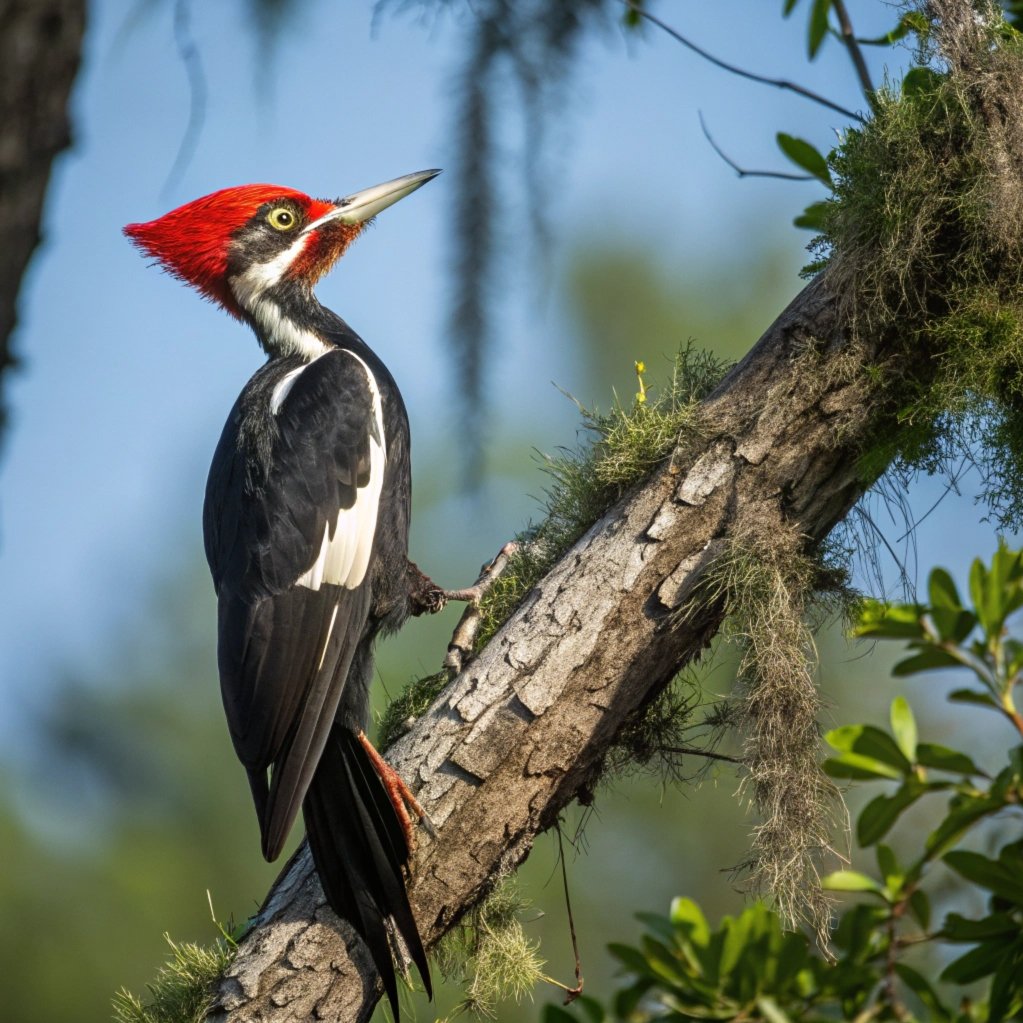
The Ivory-billed Woodpecker (Campephilus principalis) holds a legendary status in Florida’s ornithological history. Once considered extinct, this large and striking woodpecker has been the subject of intense debate and search efforts in recent years.
Historically, the Ivory-billed Woodpecker inhabited old-growth forests in the southeastern United States, including parts of Florida.
With its distinctive appearance – a large black body, white wing patches, and a bright red crest – the Ivory-billed Woodpecker was often referred to as the “Lord God Bird” due to its impressive size and beauty.
While there have been no confirmed sightings in Florida for decades, the possibility of its existence continues to captivate researchers and bird enthusiasts.
The story of the Ivory-billed Woodpecker serves as a poignant reminder of the importance of habitat conservation and the potential consequences of losing unique species.
Whether or not this magnificent bird still exists in Florida’s remote swamps and forests remains one of ornithology’s greatest mysteries.
Conservation and Appreciation of Florida’s Woodpeckers
The diverse array of woodpecker species in Florida plays a crucial role in the state’s ecosystems, from controlling insect populations to creating habitats for other wildlife. However, many of these fascinating birds face challenges due to habitat loss and environmental changes.
Conservation efforts in Florida focus on preserving and managing suitable habitats, such as mature forests and snags, which are essential for woodpecker nesting and foraging. Artificial nest cavities and bird feeders can help support woodpecker populations in urban and suburban areas.
For birdwatchers and nature enthusiasts, Florida offers numerous opportunities to observe woodpeckers in their natural habitats. Popular locations include the Apalachicola National Forest, Ocala National Forest, Myakka River State Park, and various wildlife refuges across the state.
By appreciating and understanding these remarkable birds, we can contribute to their conservation and the preservation of Florida’s unique ecosystems.
As we continue to learn more about Florida’s woodpeckers, their behaviors, and their ecological importance, we can work towards ensuring that these colorful and fascinating birds remain a vibrant part of the Sunshine State’s natural heritage for generations to come.
FAQs
What is the most common woodpecker in Florida?
The Red-bellied Woodpecker is the most common woodpecker species in Florida, with the highest number of recorded sightings according to eBird data.
How many species of woodpeckers can be found in Florida?
There are at least eight common woodpecker species in Florida, with reports of up to ten different species observed over time.
Are woodpeckers protected in Florida?
Yes, woodpeckers are protected in Florida under the Migratory Bird Treaty Act, along with other native bird species.
Where do woodpeckers nest in Florida?
Most woodpeckers in Florida nest in cavities in dead trees, dead palms, and snags on live trees. The Red-cockaded Woodpecker is unique in nesting in live pine trees.
What is the largest woodpecker species in Florida?
The Pileated Woodpecker is the largest woodpecker species found in Florida, weighing about 10.5 ounces.
How can I attract woodpeckers to my backyard in Florida?
To attract woodpeckers to your backyard in Florida, you can provide suet feeders, maintain dead trees or snags when safe to do so, and plant native fruit-bearing trees and shrubs.
What role do woodpeckers play in Florida’s ecosystems?
Woodpeckers play crucial roles in Florida’s ecosystems by controlling insect populations, creating nesting cavities for other wildlife, and helping to disperse seeds.
Are there any endangered woodpecker species in Florida?
Yes, the Red-cockaded Woodpecker is considered endangered due to habitat loss and specific nesting requirements in mature pine forests.
What is the best time of day to observe woodpeckers in Florida?
The best times to observe woodpeckers in Florida are typically early morning and late afternoon when they are most active in foraging and drumming.
How can I distinguish between different woodpecker species in Florida?
You can distinguish between woodpecker species by observing their size, plumage patterns, behavior, and habitat preferences. Field guides and birding apps can be helpful tools for identification.

Hello, I’m Emily Price, the founder of Birds Affection. As a passionate bird enthusiast and spiritual seeker, I’ve always been fascinated by the symbolic meanings and mystical connections between birds and our lives. On this website, I share my knowledge and insights on the spiritual significance of various bird species, exploring their roles as messengers, guides, and teachers. Through my writing, I aim to inspire and educate others on the profound wisdom and beauty that birds bring to our world. Join me on this journey as we delve into the enchanting realm of bird symbolism and discover the hidden meanings behind these magnificent creatures.

